Reactive HiTUS TiNbVTaZrHf-Nx Coatings: Structure, Composition and Mechanical Properties
Abstract
1. Introduction
2. Experimental Procedure
2.1. Coating Deposition
2.2. Structure, Mechanical Properties, and Thermal Stability
3. Results
3.1. Plasma Conditions during Reactive HiTUS
- full consumption of nitrogen at nitrogen flows below 8 sccm;
- decrease and saturation of nitrogen consumption at flows above 8 sccm.
3.2. Deposition, Structure, Phase, and Chemical Composition of Coatings
3.2.1. Deposition and Deposition Rates
3.2.2. Structure and Chemical Composition
3.2.3. Phase Composition
3.2.4. Mechanical Properties
4. Discussion
5. Conclusions
- Formation of sub- and near-stoichiometric nitride structure from high entropy stabilized metallic system during reactive HiTUS can be described by a gradual increase of the occupancy of octahedral interstitial position in the face-centered cubic lattice by nitrogen atoms;
- The highest values of hardness HIT ~ 33 GPa and indentation modulus EIT ~ 400 GPa were achieved in slightly sub-stoichiometric (~42 at% nitrogen) coatings;
- Hysteresis behavior in reactive HiTUS is significantly suppressed. The structure and mechanical properties of the studied TiNbVTaZrHf-xN coatings can be controlled only by the amount of reactive nitrogen without a need for feedback control;
- HiTUS and reactive HiTUS are suitable for the deposition of 6-TM alloy and nitride coatings characterized as homogeneous solid solutions with metallic sub-lattice stabilized by high configurational entropy.
Author Contributions
Funding
Institutional Review Board Statement
Informed Consent Statement
Data Availability Statement
Acknowledgments
Conflicts of Interest
References
- Oses, C.; Toher, C.; Curtarolo, S. High-entropy ceramics. Nat. Rev. Mater. 2020, 5, 295–309. [Google Scholar] [CrossRef]
- Xiang, H.; Xing, Y.; Dai, F.-Z.; Wang, H.; Su, L.; Miao, L.; Zhang, G.; Wang, Y.; Qi, X.; Yao, L.; et al. High-entropy ceramics: Present status, challenges, and a look forward. J. Adv. Ceram. 2021, 10, 385–441. [Google Scholar] [CrossRef]
- Cantor, B.; Chang, I.T.H.; Knight, P.; Vincent, A.J.B. Microstructural development in equiatomic multicomponent alloys. Mater. Sci. Eng. A 2004, 375–377, 213–218. [Google Scholar] [CrossRef]
- Yeh, J.-W.; Chen, S.K.; Lin, S.-J.; Gan, J.-Y.; Chin, T.-S.; Shun, T.-T.; Tsau, C.-H.; Chang, S.-Y. Nanostructured High-Entropy Alloys with Multiple Principal Elements: Novel Alloy Design Concepts and Outcomes. Adv. Eng. Mater. 2004, 6, 299–303. [Google Scholar] [CrossRef]
- Yeh, J.-W. Recent progress in high-entropy alloys. Eur. J. Control 2006, 31, 633–648. [Google Scholar] [CrossRef]
- Miracle, D.B.; Senkov, O.N. A critical review of high entropy alloys and related concepts. Acta Mater. 2017, 122, 448–511. [Google Scholar] [CrossRef]
- Gild, J.; Zhang, Y.; Harrington, T.; Jiang, S.; Hu, T.; Quinn, M.C.; Mellor, W.M.; Zhou, N.; Vecchio, K.; Luo, J. High-Entropy Metal Diborides: A New Class of High-Entropy Materials and a New Type of Ultrahigh Temperature Ceramics. Sci. Rep. 2016, 6, 37946. [Google Scholar] [CrossRef]
- Sarker, P.; Harrington, T.; Toher, C.; Oses, C.; Samiee, M.; Maria, J.-P.; Brenner, D.W.; Vecchio, K.S.; Curtarolo, S. High-entropy high-hardness metal carbides discovered by entropy descriptors. Nat. Commun. 2018, 9, 4980. [Google Scholar] [CrossRef]
- Sobol, O.; Andreev, A.; Gorban’, V.F.; Krapivka, N.A.; Stolbovoi, V.A.; Serdyuk, I.V.; Fil’chikov, V.E. Reproducibility of the single-phase structural state of the multielement high-entropy Ti-V-Zr-Nb-Hf system and related superhard nitrides formed by the vacuum-arc method. Technol. Phys. Lett. 2012, 38, 616–619. [Google Scholar] [CrossRef]
- Braic, V.; Balaceanu, M.; Braic, M.; Vladescu, A.; Panseri, S.; Russo, A. Characterization of multi-principal-element (TiZrNbHfTa)N and (TiZrNbHfTa)C coatings for biomedical applications. J. Mech. Behav. Biomed. Mater. 2012, 10, 197–205. [Google Scholar] [CrossRef]
- Rost, C.M.; Sachet, E.; Borman, T.; Moballegh, A.; Dickey, E.C.; Hou, D.; Jones, J.L.; Curtarolo, S.; Maria, J.-P. Entropy-stabilized oxides. Nat. Commun. 2015, 6, 8485. [Google Scholar] [CrossRef]
- Lewin, E. Multi-component and high-entropy nitride coatings—A promising field in need of a novel approach. J. Appl. Phys. 2020, 127, 160901. [Google Scholar] [CrossRef]
- Sarkar, A.; Wang, Q.; Schiele, A.; Chellali, M.R.; Bhattacharya, S.S.; Wang, D.; Brezesinski, T.; Hahn, H.; Velasco, L.; Breitung, B. High-Entropy Oxides: Fundamental Aspects and Electrochemical Properties. Adv. Mater. 2019, 31, e1806236. [Google Scholar] [CrossRef]
- Shaha, K.P.; Rueβ, H.; Rotert, S.; Baben, M.T.; Music, D.; Schneider, J.M. Nonmetal sublattice population induced defect structure in transition metal aluminum oxynitrides. Appl. Phys. Lett. 2013, 103, 221905. [Google Scholar] [CrossRef]
- Kirnbauer, A.; Kretschmer, A.; Koller, C.; Wojcik, T.; Paneta, V.; Hans, M.; Schneider, J.; Polcik, P.; Mayrhofer, P. Mechanical properties and thermal stability of reactively sputtered multi-principal-metal Hf-Ta-Ti-V-Zr nitrides. Surf. Coat. Technol. 2020, 389, 125674. [Google Scholar] [CrossRef]
- Sharma, A. High Entropy Alloy Coatings and Technology. Coatings 2021, 11, 372. [Google Scholar] [CrossRef]
- El Garah, M.; Briois, P.; Sanchette, F. Recent Progress on High-Entropy Films Deposited by Magnetron Sputtering. Crystals 2022, 12, 335. [Google Scholar] [CrossRef]
- Chen, T.-K.; Shun, T.; Yeh, J.; Wong, M. Nanostructured nitride films of multi-element high-entropy alloys by reactive DC sputtering. Surf. Coat. Technol. 2004, 188–189, 193–200. [Google Scholar] [CrossRef]
- Liang, S.-C.; Tsai, D.-C.; Chang, Z.-C.; Sung, H.-S.; Lin, Y.-C.; Yeh, Y.-J.; Deng, M.-J.; Shieu, F.-S. Structural and mechanical properties of multi-element (TiVCrZrHf)N coatings by reactive magnetron sputtering. Appl. Surf. Sci. 2011, 258, 399–403. [Google Scholar] [CrossRef]
- Pogrebnjak, A.D.; Yakushchenko, I.V.; Abadias, G.; Chartier, P.; Bondar, O.V.; Beresnev, V.M.; Takeda, Y.; Sobol, O.; Oyoshi, K.; Andreyev, A.A.; et al. The effect of the deposition parameters of nitrides of high-entropy alloys (TiZrHfVNb)N on their structure, composition, mechanical and tribological properties. J. Superhard Mater. 2013, 35, 356–368. [Google Scholar] [CrossRef]
- Braic, V.; Vladescu, A.; Balaceanu, M.; Luculescu, C.; Braic, M. Nanostructured multi-element (TiZrNbHfTa)N and (TiZrNbHfTa)C hard coatings. Surf. Coat. Technol. 2012, 211, 117–121. [Google Scholar] [CrossRef]
- Grigoriev, S.N.; Sobol’, O.; Beresnev, V.M.; Serdyuk, I.V.; Pogrebnyak, A.D.; Kolesnikov, D.A.; Nemchenko, U.S. Tribological characteristics of (TiZrHfVNbTa)N coatings applied using the vacuum arc deposition method. J. Frict. Wear 2014, 35, 359–364. [Google Scholar] [CrossRef]
- Pogrebnjak, A.D.; Yakushchenko, I.V.; Bondar, O.V.; Sobol’, O.; Beresnev, V.M.; Oyoshi, K.; Amekura, H.; Takeda, Y. Influence of implantation of Au− ions on the microstructure and mechanical properties of the nanostructured multielement (TiZrHf VNbTa)N coating. Phys. Solid State 2015, 57, 1559–1564. [Google Scholar] [CrossRef]
- Xu, Y.; Li, G.; Li, G.; Gao, F.; Xia, Y. Effect of bias voltage on the growth of super-hard (AlCrTiVZr)N high-entropy alloy nitride films synthesized by high power impulse magnetron sputtering. Appl. Surf. Sci. 2021, 564, 150417. [Google Scholar] [CrossRef]
- Xu, Y.; Li, G.; Xia, Y. Synthesis and characterization of super-hard AlCrTiVZr high-entropy alloy nitride films deposited by HiPIMS. Appl. Surf. Sci. 2020, 523, 146529. [Google Scholar] [CrossRef]
- Bachani, S.K.; Wang, C.-J.; Lou, B.-S.; Chang, L.-C.; Lee, J.-W. Fabrication of TiZrNbTaFeN high-entropy alloys coatings by HiPIMS: Effect of nitrogen flow rate on the microstructural development, mechanical and tribological performance, electrical properties and corrosion characteristics. J. Alloys Compd. 2021, 873, 159605. [Google Scholar] [CrossRef]
- Thwaites, M.J. High Density Plasmas. UK Patent No. GB2343992 (A), 20 November 1998. [Google Scholar]
- Wakeham, S.; Thwaites, M.; Holton, B.; Tsakonas, C.; Cranton, W.; Koutsogeorgis, D.; Ranson, R. Low temperature remote plasma sputtering of indium tin oxide for flexible display applications. Thin Solid Films 2009, 518, 1355–1358. [Google Scholar] [CrossRef]
- Lofaj, F.; Kvetková, L.; Hviščová, P.; Gregor, M.; Ferdinandy, M. Reactive processes in the high target utilization sputtering (HiTUS) W-C based coatings. J. Eur. Ceram. Soc. 2016, 36, 3029–3040. [Google Scholar] [CrossRef]
- Lofaj, F.; Hviščová, P.; Zubko, P.; Németh, D.; Kabátová, M. Mechanical and tribological properties of the High Target Utilization Sputtering W-C coatings on different substrates. Int. J. Refract. Met. Hard Mater. 2019, 80, 305–314. [Google Scholar] [CrossRef]
- Lofaj, F.; Kabátová, M.; Kvetková, L.; Dobrovodský, J. The effects of deposition conditions on hydrogenation, hardness and elastic modulus of W-C:H coatings. J. Eur. Ceram. Soc. 2019, 40, 2721–2730. [Google Scholar] [CrossRef]
- Lofaj, F.; Kabátová, M.; Kvetková, L.; Dobrovodský, J.; Girman, V. Hybrid PVD-PECVD W-C:H coatings prepared by different sputtering techniques: The comparison of deposition processes, composition and properties. Surf. Coat. Technol. 2019, 375, 839–853. [Google Scholar] [CrossRef]
- Noga, P.; Dobrovodský, J.; Vaňa, D.; Beňo, M.; Závacká, A.; Muška, M.; Halgaš, R.; Minárik, S.; Riedlmajer, R. A new ion-beam laboratory for materials research at the Slovak University of Technology. Nucl. Instrum. Methods Phys. Res. Sect. B Beam Interact. Mater. Atoms. 2017, 409, 264–267. [Google Scholar] [CrossRef]
- Dobrovodský, J.; Beňo, M.; Vaňa, D.; Bezák, P.; Noga, P. The first year operation experience with Ion Beam Analysis at the new STU Ion Beam Laboratory. Nucl. Instrum. Methods Phys. Res. Sect. B Beam Interact. Mater. Atoms. 2018, 450, 168–172. [Google Scholar] [CrossRef]
- Nastasi, M.; Mayer, M.; Wang, Y. Ion Beam Analysis; CRC Press: Boca Raton, FL, USA, 2014. [Google Scholar] [CrossRef]
- Lanford, W.; Pelicon, P.; Zorko, B.; Budnar, M. Use of reference samples for more accurate RBS analyses. Nucl. Instrum. Methods Phys. Res. Sect. B Beam Interact. Mater. Atoms. 2002, 190, 410–413. [Google Scholar] [CrossRef]
- SIMNRA. Available online: https://mam.home.ipp.mpg.de/index.html (accessed on 3 January 2023).
- About GUPIX and GUPIXWIN. Available online: https://www.physics.uoguelph.ca/about-gupix-and-gupixwin (accessed on 3 January 2023).
- Gurbich, A. SigmaCalc recent development and present status of the evaluated cross-sections for IBA. Nucl. Instrum. Methods Phys. Res. Sect. B Beam Interact. Mater. Atoms. 2016, 371, 27–32. [Google Scholar] [CrossRef]
- Terwagne, G.; Genard, G.; Yedji, M.; Ross, G.G. Cross-section measurements of the N14(α,p)O17 and N14(α,α)N14 reactions between 3.5 and 6 MeV. J. Appl. Phys. 2008, 104, 084909. [Google Scholar] [CrossRef]
- Hay, J.; Crawford, B. Measuring substrate-independent modulus of thin films. J. Mater. Res. 2011, 26, 727–738. [Google Scholar] [CrossRef]
- Merle, B.; Maier-Kiener, V.; Pharr, G.M. Influence of modulus-to-hardness ratio and harmonic parameters on continuous stiffness measurement during nanoindentation. Acta Mater. 2017, 134, 167–176. [Google Scholar] [CrossRef]
- Oliver, W.C.; Pharr, G.M. An improved technique for determining hardness and elastic modulus using load and displacement sensing indentation experiments. J. Mater. Res. 1992, 7, 1564–1583. [Google Scholar] [CrossRef]
- Sproul, W.; Christie, D.; Carter, D. Control of reactive sputtering processes. Thin Solid Films 2005, 491, 1–17. [Google Scholar] [CrossRef]
- Berg, S.; Nyberg, T. Fundamental understanding and modeling of reactive sputtering processes. Thin Solid Film. 2005, 476, 215–230. [Google Scholar] [CrossRef]
- Lofaj, F.; Kabátová, M.; Dobrovodský, J.; Cempura, G. Hydrogenation and hybridization in hard W-C:H coatings prepared by hybrid PVD-PECVD method with methane and acetylene. Int. J. Refract. Met. Hard Mater. 2020, 88, 105211. [Google Scholar] [CrossRef]
- Fritze, S.; Koller, C.M.; von Fieandt, L.; Malinovskis, P.; Johansson, K.; Lewin, E.; Mayrhofer, P.H.; Jansson, U. Influence of Deposition Temperature on the Phase Evolution of HfNbTiVZr High-Entropy Thin Films. Materials 2019, 12, 587. [Google Scholar] [CrossRef] [PubMed]
- Von Fieandt, K.; Pilloud, D.; Fritze, S.; Osinger, B.; Pierson, J.-F.; Lewin, E. Optical and electrical properties of hard (Hf,Nb,Ti,V,Zr)Nx thin films. Vacuum 2021, 193, 110517. [Google Scholar] [CrossRef]
- Karlsson, D.; Ek, G.; Cedervall, J.; Zlotea, C.; Møller, K.T.; Hansen, T.C.; Bednarčík, J.; Paskevicius, M.; Sørby, M.H.; Jensen, T.R.; et al. Structure and Hydrogenation Properties of a HfNbTiVZr High-Entropy Alloy. Inorg. Chem. 2018, 57, 2103–2110. [Google Scholar] [CrossRef]
- Pacheco, V.; Lindwall, G.; Karlsson, D.; Cedervall, J.; Fritze, S.; Ek, G.; Berastegui, P.; Sahlberg, M.; Jansson, U. Thermal Stability of the HfNbTiVZr High-Entropy Alloy. Inorg. Chem. 2018, 58, 811–820. [Google Scholar] [CrossRef]
- Johansson, K.; Riekehr, L.; Fritze, S.; Lewin, E. Multicomponent Hf-Nb-Ti-V-Zr nitride coatings by reactive magnetron sputter deposition. Surf. Coat. Technol. 2018, 349, 529–539. [Google Scholar] [CrossRef]
- Leyland, A.; Matthews, A. On the significance of the H/E ratio in wear control: A nanocomposite coating approach to optimised tribological behaviour. Wear 2000, 246, 1–11. [Google Scholar] [CrossRef]
- Musil, J.; Jirout, M. Toughness of hard nanostructured ceramic thin films. Surf. Coat. Technol. 2007, 201, 5148–5152. [Google Scholar] [CrossRef]
- Sebastiani, M.; Johanns, K.; Herbert, E.; Carassiti, F.; Pharr, G. A novel pillar indentation splitting test for measuring fracture toughness of thin ceramic coatings. Philos. Mag. 2014, 95, 1928–1944. [Google Scholar] [CrossRef]
- Sebastiani, M.; Johanns, K.E.; Herbert, E.G.; Pharr, G.M. Measurement of fracture toughness by nanoindentation methods: Recent advances and future challenges. Curr. Opin. Solid State Mater. Sci. 2015, 19, 324–333. [Google Scholar] [CrossRef]
- Available online: https://en.wikipedia.org/wiki/Atomic_radii_of_the_elements_(data_page) (accessed on 3 January 2023).
- Blank, H. Hägg’s rule and fast solute diffusion in cubic transition-metal phases. Philos. Mag. B 1996, 73, 833–844. [Google Scholar] [CrossRef]
- Floro, J.; Thompson, C.; Carel, R.; Bristowe, P. Competition between strain and interface energy during epitaxial grain growth in Ag films on Ni(001). J. Mater. Res. 1994, 9, 2411–2424. [Google Scholar] [CrossRef]
- Zielinski, E.M.; Vinci, R.P.; Bravman, J.C. Effects of barrier layer and annealing on abnormal grain growth in copper thin films. J. Appl. Phys. 1994, 76, 4516–4523. [Google Scholar] [CrossRef]
- Ellis, E.A.; Chmielus, M.; Lin, M.-T.; Joress, H.; Visser, K.; Woll, A.; Vinci, R.P.; Brown, W.L.; Baker, S.P. Driving forces for texture transformation in thin Ag films. Acta Mater. 2016, 105, 495–504. [Google Scholar] [CrossRef]
- Mayrhofer, P.H.; Geier, M.; Löcker, C.; Chen, L. Influence of deposition conditions on texture development and mechanical properties of TiN coatings. Int. J. Mater. Res. 2009, 100, 1052–1058. [Google Scholar] [CrossRef]

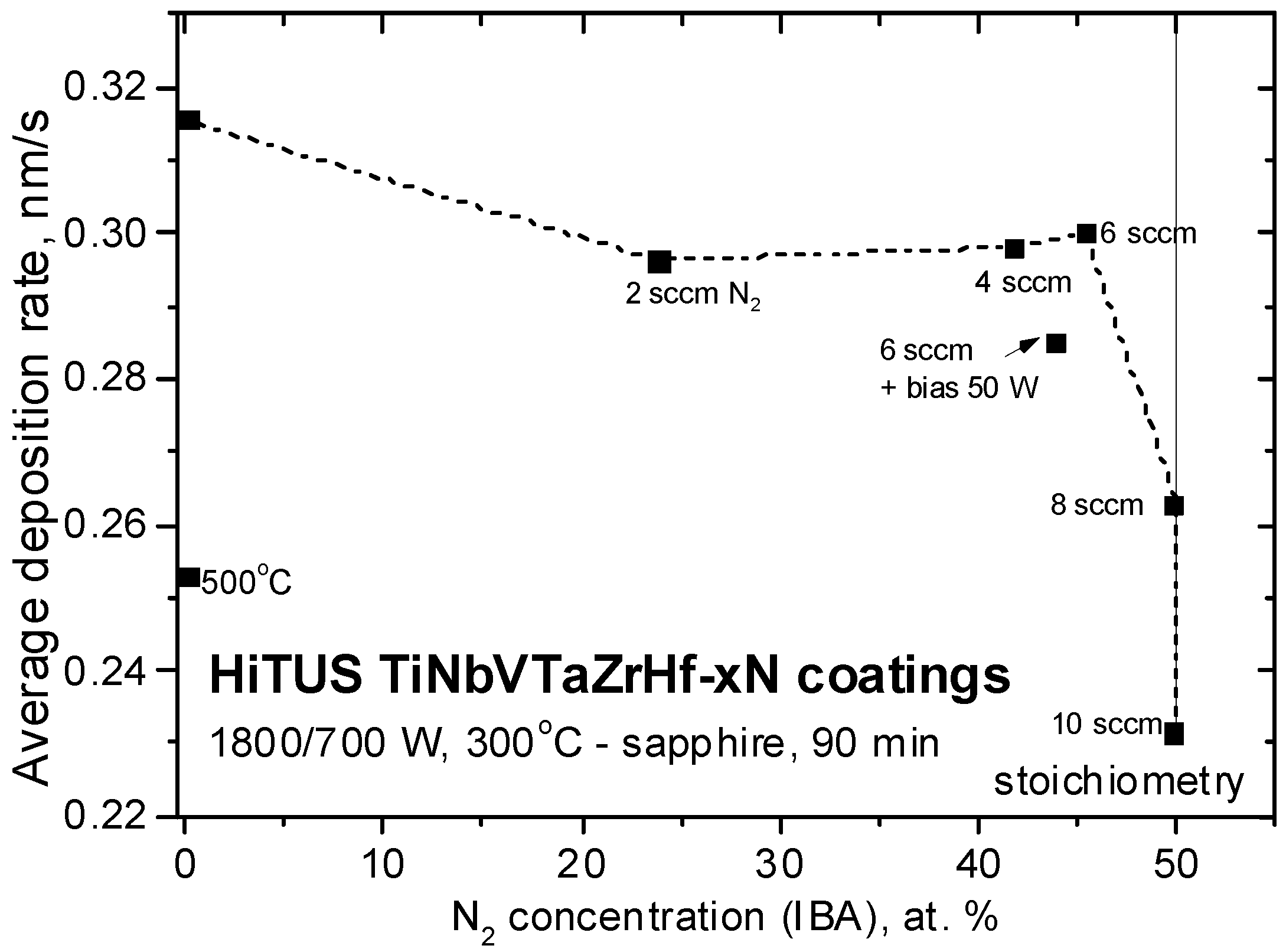
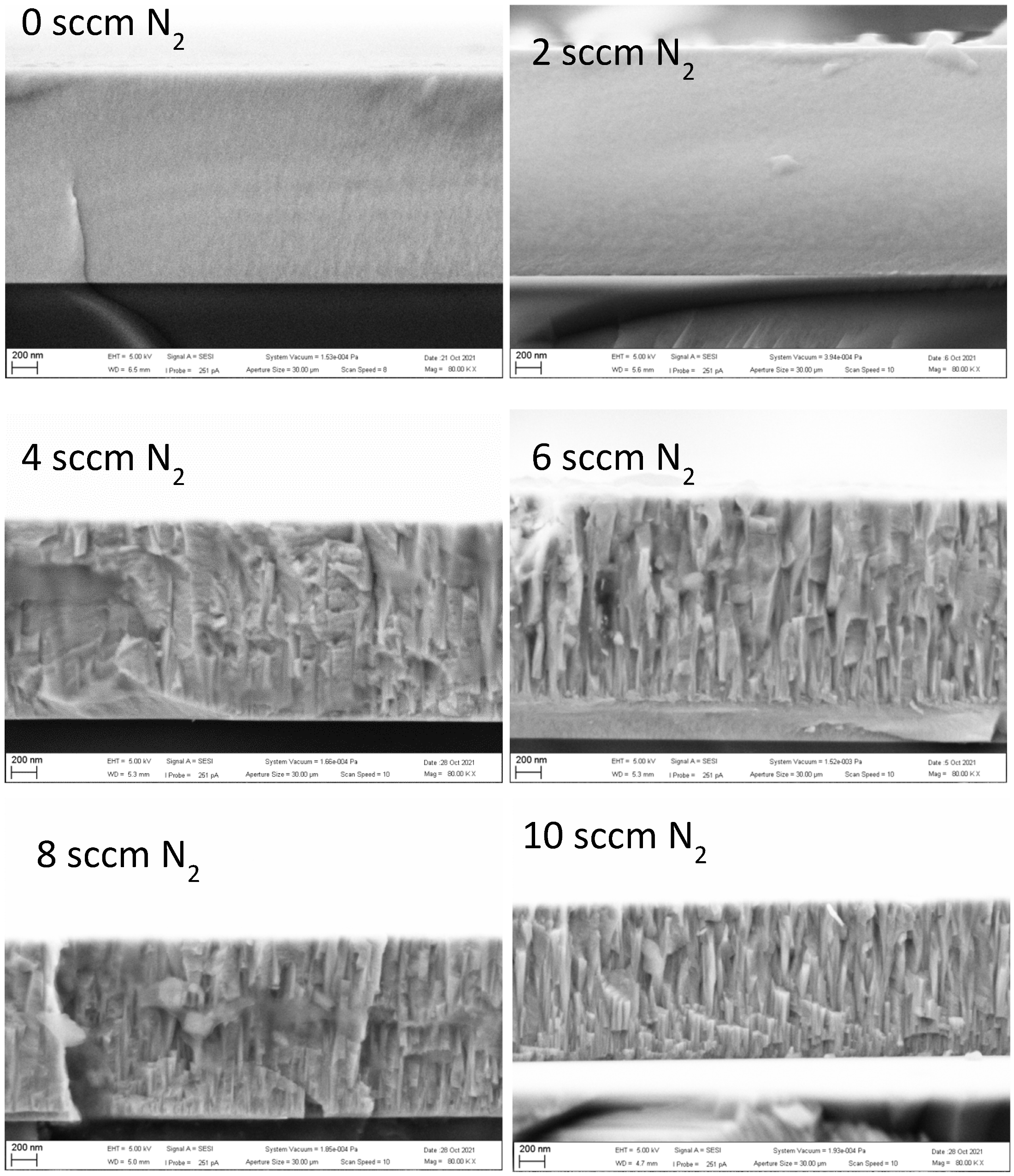
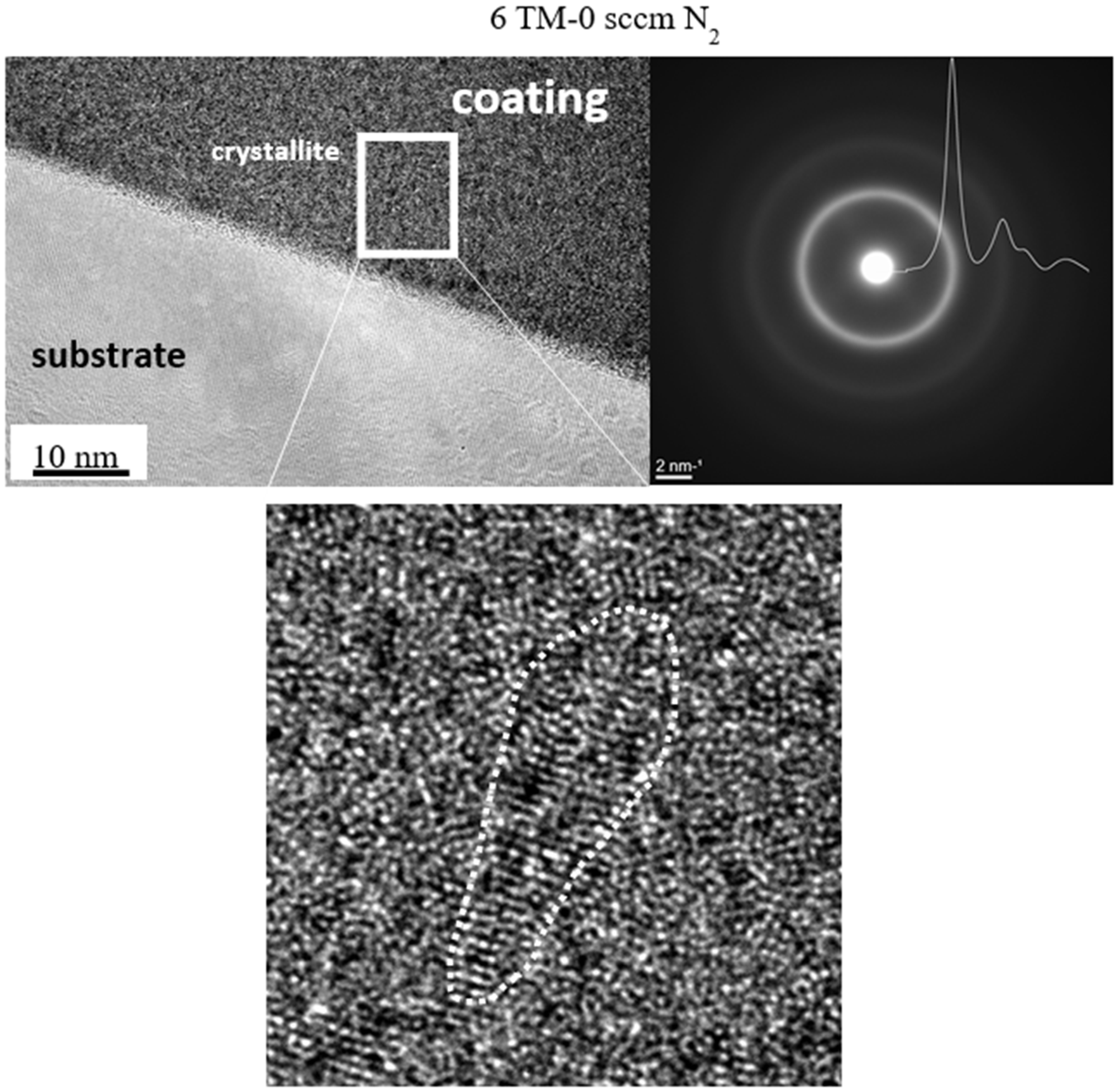

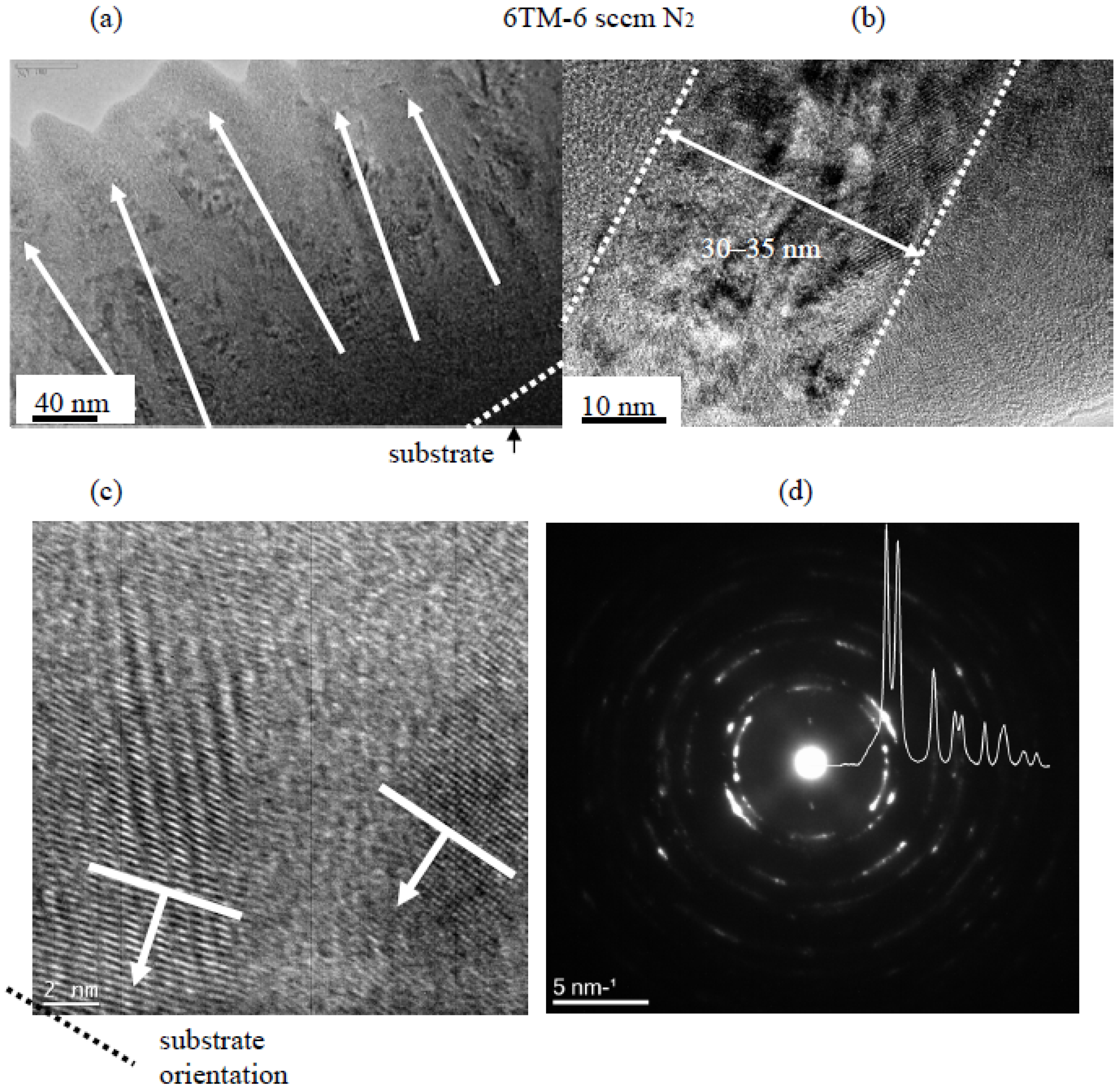

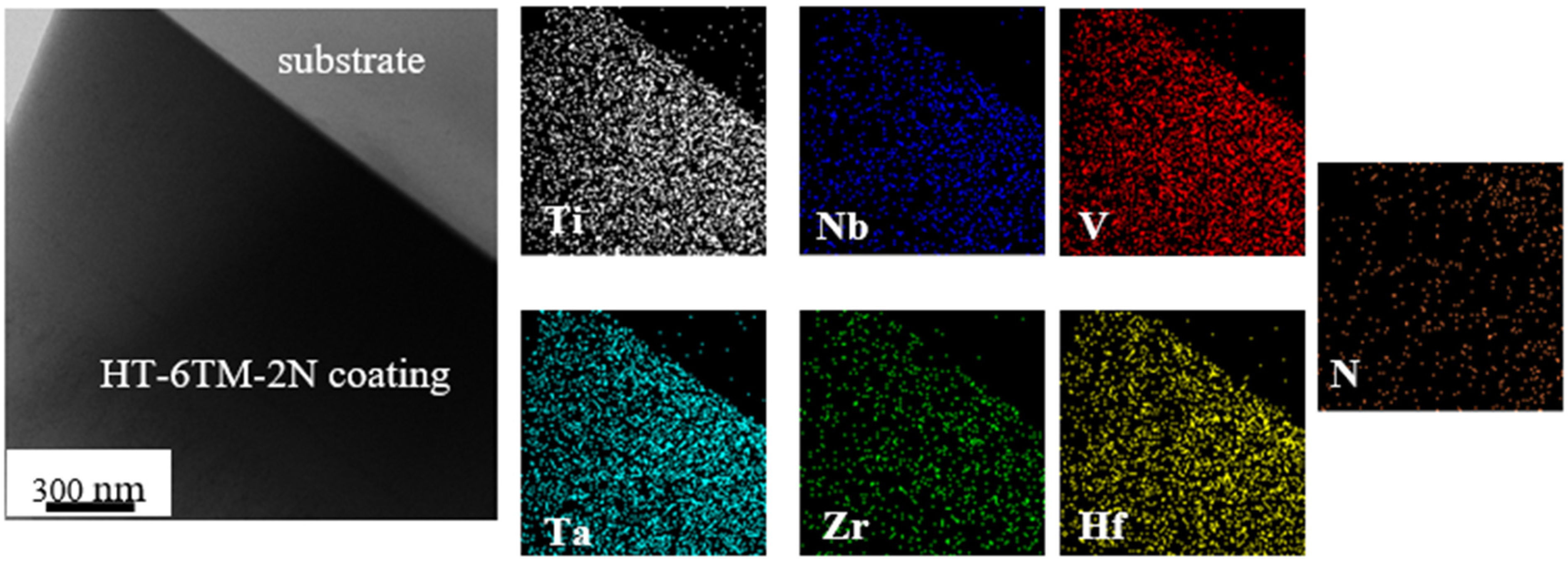
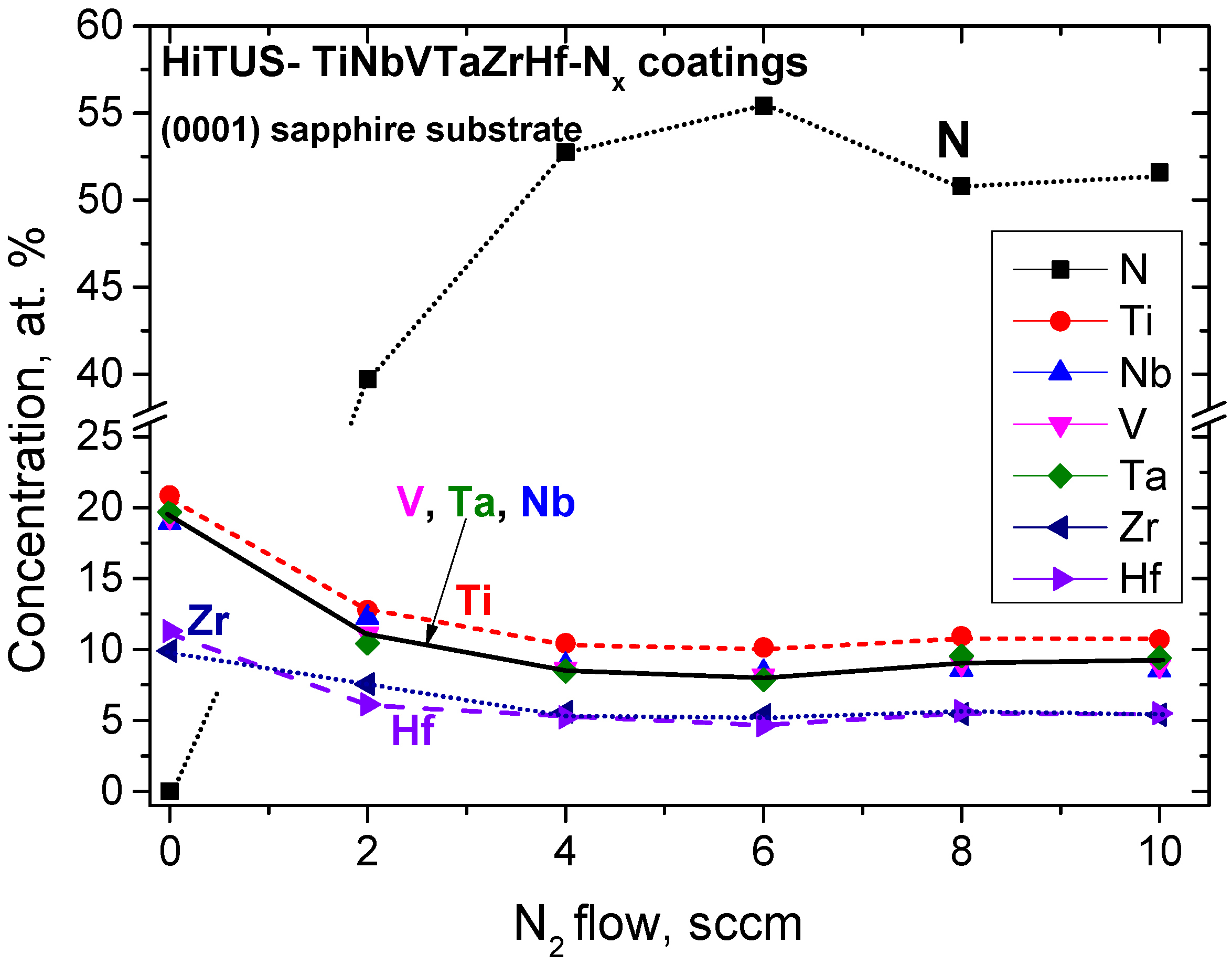

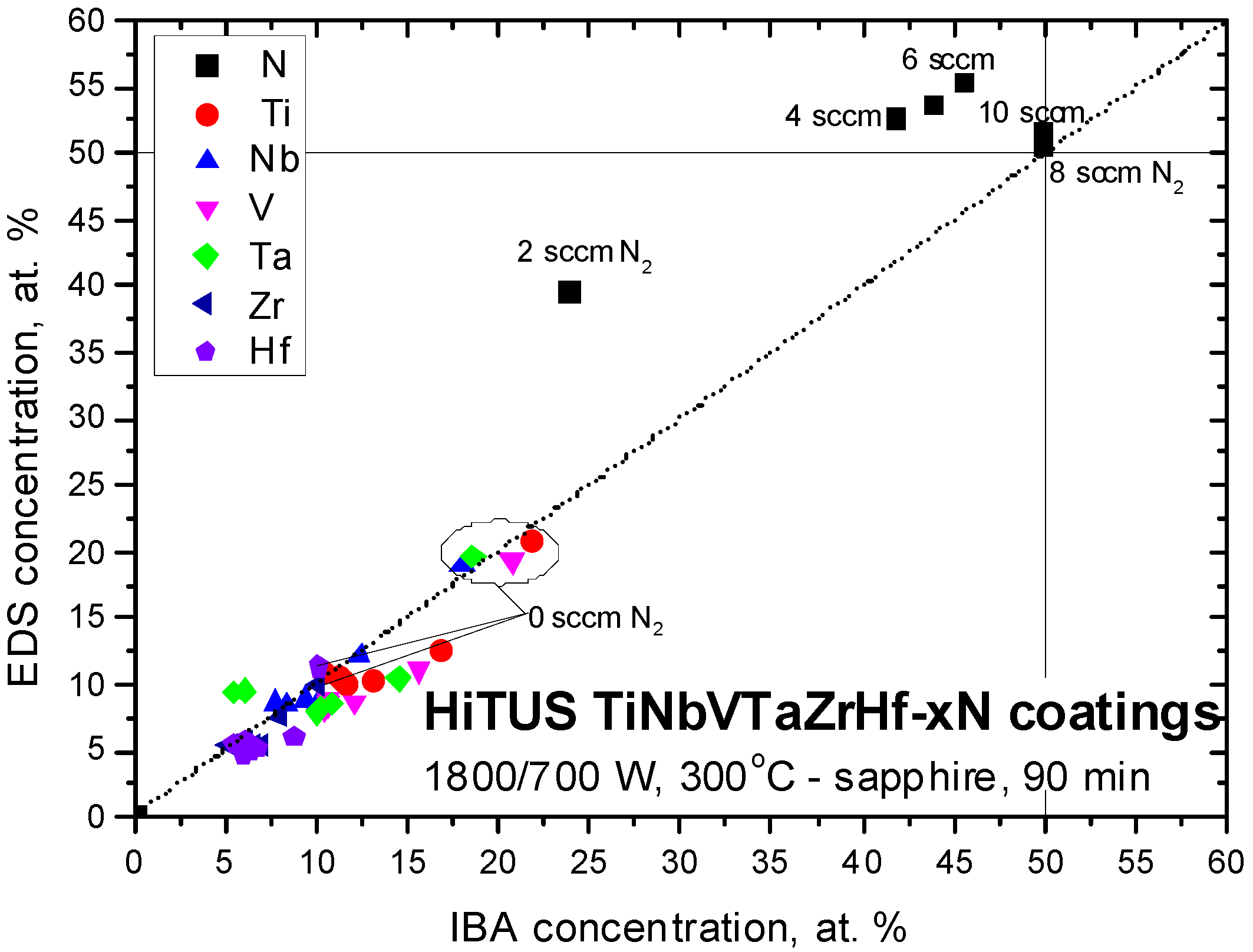

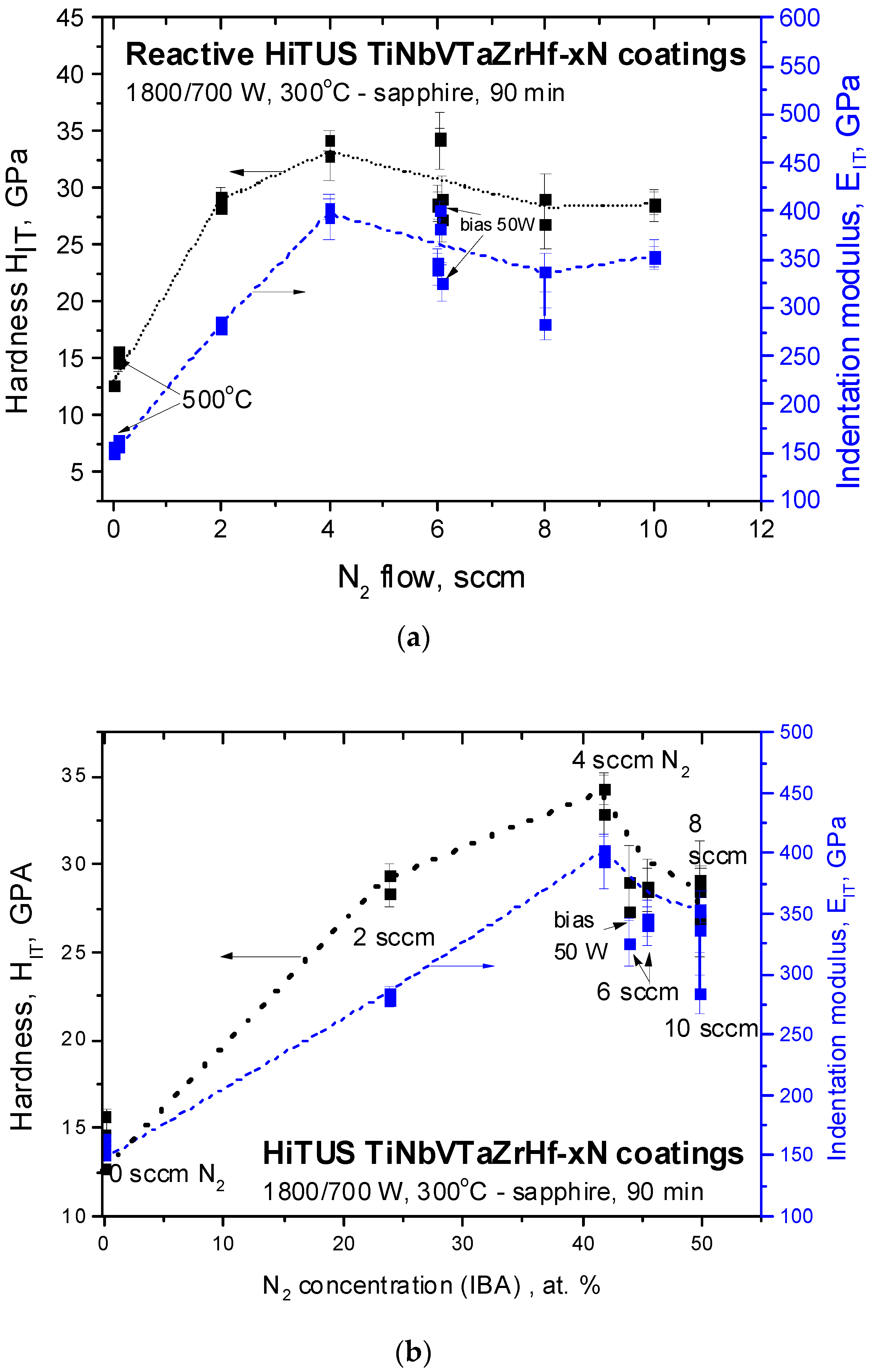
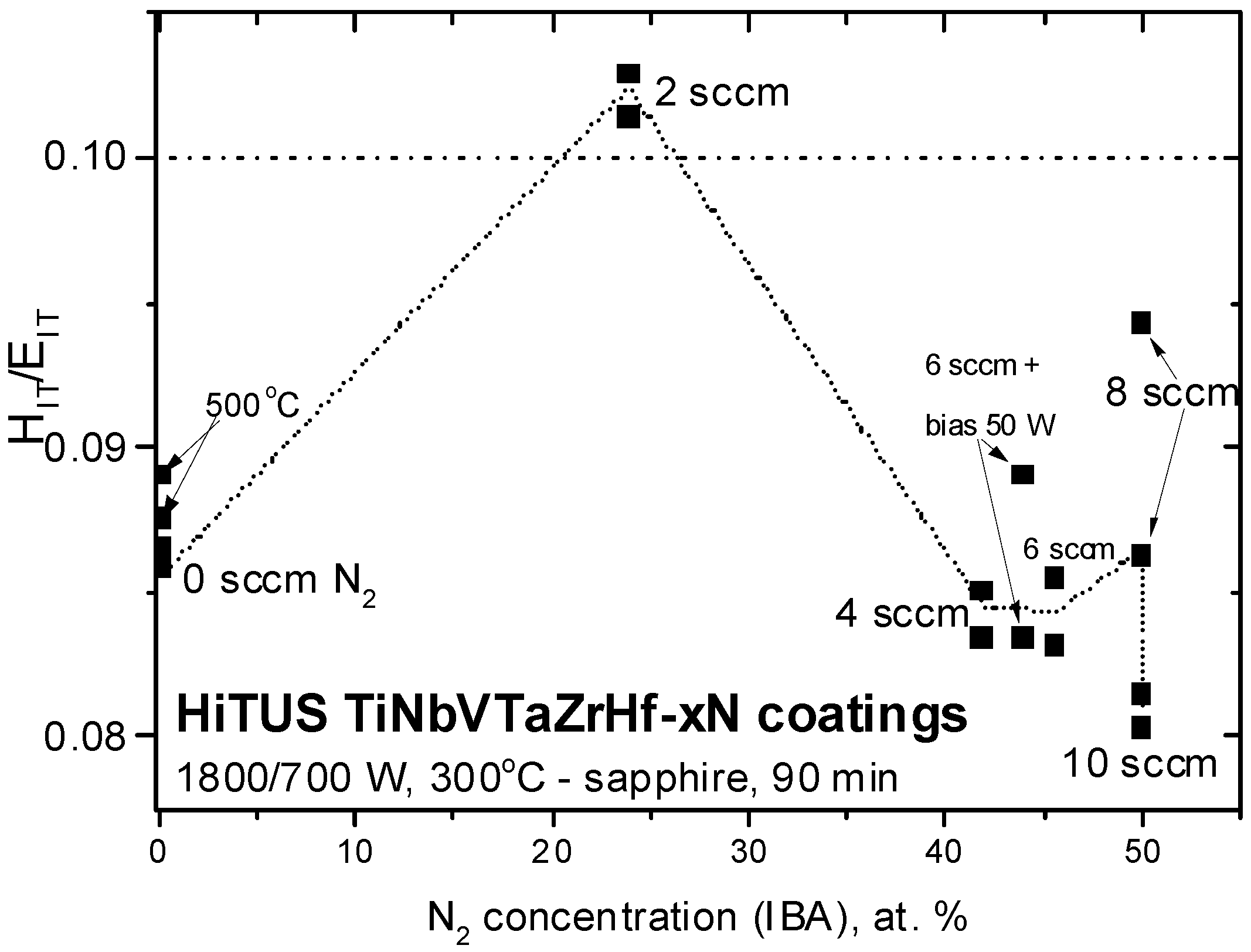
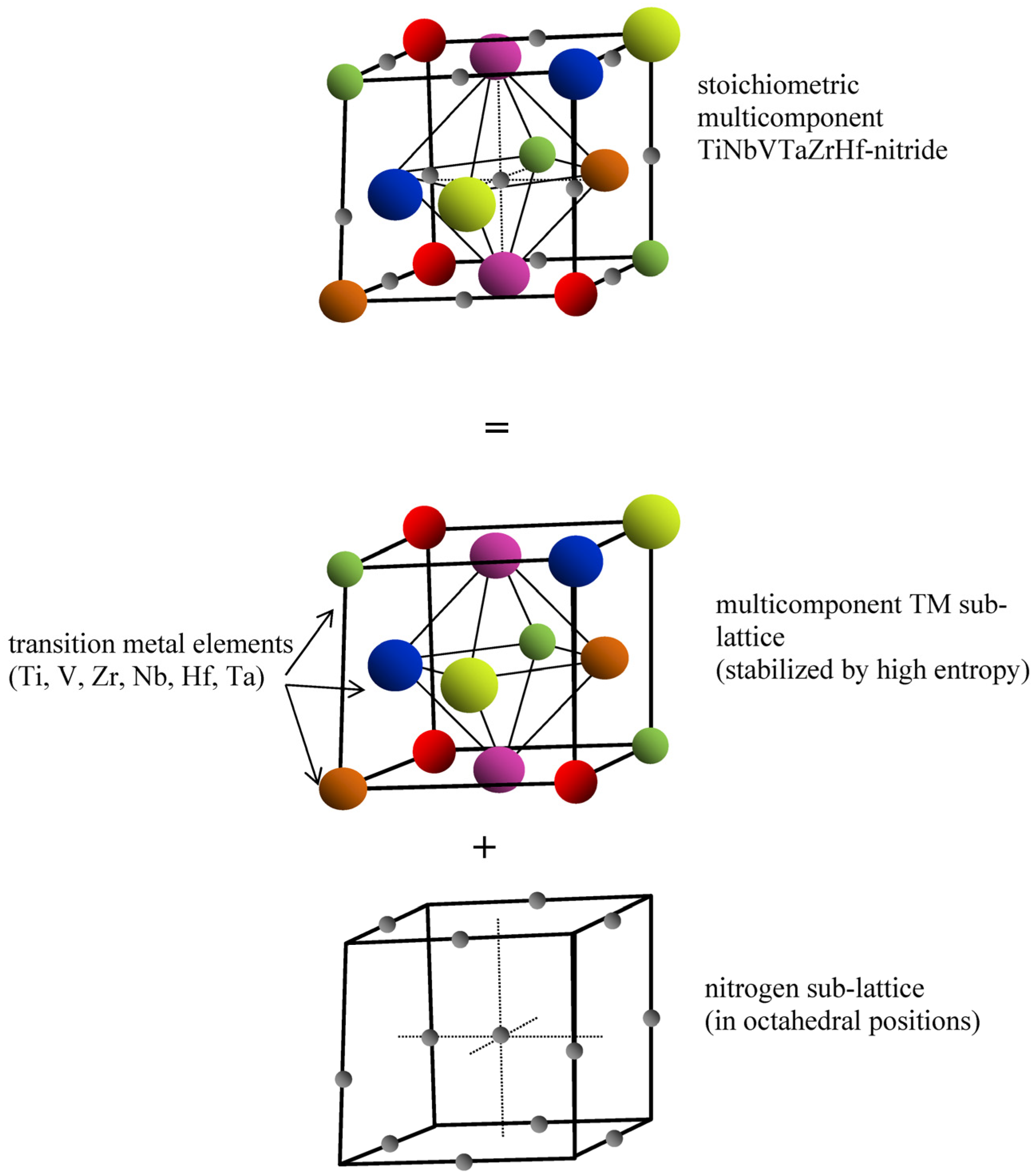
| Target | Ti, at% | Nb, at% | V, at% | Ta, at% | Zr, at% | Hf, at% |
|---|---|---|---|---|---|---|
| Nominal composition | 20 | 18 | 20 | 18 | 12 | 12 |
| EDS * composition (after sputtering without nitrogen) | 18.5 ± 1.9 | 19.6 ± 1.3 | 26.4 ± 3.6 | 13.0 ± 0.4 | 10.4 ± 0.3 | 12.1 ± 0.7 |
| Sample | N2 Flow sccm | Thickness nm |
|---|---|---|
| HT-6TM-0N | 0 | 1705 |
| HT-6TM-0N-500 °C | 0 | 1370 |
| HT-6TM-2N | 2 | 1600 |
| HT-6TM-4N | 4 | 1610 |
| HT-6TM-6N | 6 | 1620 |
| HT-6TM-6N-50Wbias | 6 | 1540 |
| HT-6TM-8N | 8 | 1420 |
| HT-6TM-10N | 10 | 1250 |
| TM | EDS/SEM Concentration in the Target at% * | EDS/TEM Concentration at% (Thin Foil) * | EDS/SEM Concentration at% (Top View) * |
|---|---|---|---|
| Ti | 18.5 ± 1.9 | 32.1 ± 4.7 | 20.9 ± 0.2 |
| Nb | 19.6 ± 1.3 | 17.2 ± 3.6 | 19.0 ± 0.2 |
| V | 26.4 ± 3.6 | 22.8 ± 3.3 | 19.3 ± 0.1 |
| Ta | 13.0 ± 0.4 | 14.2 ± 2.4 | 19.7 ± 0.2 |
| Zr | 10.4 ± 0.3 | 8.3 ± 1.8 | 9.9 ± 0.1 |
| Hf | 12.1 ± 0.7 | 5.5 ± 0.7 | 11.3 ± 0.1 |
| Element | N, at% | Ti, at% | Nb, at% | V, at% | Ta, at% | Zr, at% | Hf, at% |
|---|---|---|---|---|---|---|---|
| Area 1 TEM | 50.9 | 16.4 | 8.7 | 8.9 | 6.8 | 5.9 | 2.3 |
| Area 2 TEM | 43.1 | 19.7 | 9.4 | 12.2 | 6.4 | 6.5 | 2.8 |
| Area 3 TEM | 42.5 | 16.1 | 12.6 | 11.9 | 7.3 | 6.9 | 2.9 |
| Area 4 TEM | 55.4 | 14.0 | 10.5 | 8.1 | 5.3 | 5.0 | 1.9 |
| Mean ± standard deviation * | 48.0 ± 5.4 | 16.6 ± 2.0 | 10.3 ± 1.5 | 10.3 ± 1.8 | 6.4 ± 0.7 | 6.0 ± 0.7 | 2.5 ± 0.4 |
| SEM (fracture surface) | 48.0 | 11.9 | 8.0 | 9.4 | 10.7 | 5.1 | 6.3 |
| SEM (top-view) mean ± standard deviation * | 55.4 ± 0.5 | 10.1 ± 0.2 | 8.4 ± 0.1 | 8.2 ± 0.1 | 7.9 ± 0.2 | 5.3 ± 0.1 | 4.7 ± 0.1 |
| N2 Flow Sccm | N EDS at% | N IBA at% | Ti EDS at% | Ti IBA at% | Nb EDS at% | Nb IBA at% | V EDS at% | V IBA at% | Ta EDS at% | Ta IBA at% | Zr EDS at% | Zr IBA at% | Hf EDS at% | Hf IBA at% |
|---|---|---|---|---|---|---|---|---|---|---|---|---|---|---|
| 0 | 0 | 0 | 20.9 | 21.7 | 18.9 | 18.0 | 19.4 | 20.7 | 19.7 | 18.6 | 9.9 | 10.1 | 11.3 | 10.1 |
| 0 500 °C | 0 | - | 20.7 | - | 16.1 | - | 21.4 | - | 18.3 | - | 8.8 | - | 14.7 | - |
| 2 | 39.7 | 23.8 | 12.8 | 16.8 | 12.3 | 12.4 | 11.1 | 15.7 | 10.4 | 14.5 | 7.6 | 8.0 | 6.1 | 8.8 |
| 4 | 52.8 | 41.7 | 10.4 | 13.1 | 8.9 | 9.4 | 8.6 | 12.0 | 8.5 | 10.9 | 5.6 | 6.2 | 5.2 | 6.7 |
| 6 | 55.4 | 45.5 | 10.1 | 11.5 | 8.4 | 10.0 | 8.2 | 10.5 | 7.9 | 10.0 | 5.3 | 6.5 | 4.7 | 6.0 |
| 6 bias | 53.8 | 43.8 | 10.4 | 11.4 | 8.5 | 10.3 | 8.5 | 10.7 | 8.3 | 10.5 | 5.4 | 6.9 | 5.0 | 6.4 |
| 8 | 50.8 | 49.8 | 10.9 | 10.4 | 8.6 | 7.8 | 9.0 | 10.6 | 9.6 | 6.1 | 5.5 | 5.2 | 5.7 | 6.1 |
| 10 | 51.6 | 49.9 | 10.7 | 11.1 | 8.5 | 8.3 | 8.9 | 10.7 | 9.4 | 5.5 | 5.4 | 5.5 | 5.5 | 5.5 |
Disclaimer/Publisher’s Note: The statements, opinions and data contained in all publications are solely those of the individual author(s) and contributor(s) and not of MDPI and/or the editor(s). MDPI and/or the editor(s) disclaim responsibility for any injury to people or property resulting from any ideas, methods, instructions or products referred to in the content. |
© 2023 by the authors. Licensee MDPI, Basel, Switzerland. This article is an open access article distributed under the terms and conditions of the Creative Commons Attribution (CC BY) license (https://creativecommons.org/licenses/by/4.0/).
Share and Cite
Lofaj, F.; Kvetková, L.; Roch, T.; Dobrovodský, J.; Girman, V.; Kabátová, M.; Beňo, M. Reactive HiTUS TiNbVTaZrHf-Nx Coatings: Structure, Composition and Mechanical Properties. Materials 2023, 16, 563. https://doi.org/10.3390/ma16020563
Lofaj F, Kvetková L, Roch T, Dobrovodský J, Girman V, Kabátová M, Beňo M. Reactive HiTUS TiNbVTaZrHf-Nx Coatings: Structure, Composition and Mechanical Properties. Materials. 2023; 16(2):563. https://doi.org/10.3390/ma16020563
Chicago/Turabian StyleLofaj, František, Lenka Kvetková, Tomáš Roch, Jozef Dobrovodský, Vladimír Girman, Margita Kabátová, and Matúš Beňo. 2023. "Reactive HiTUS TiNbVTaZrHf-Nx Coatings: Structure, Composition and Mechanical Properties" Materials 16, no. 2: 563. https://doi.org/10.3390/ma16020563
APA StyleLofaj, F., Kvetková, L., Roch, T., Dobrovodský, J., Girman, V., Kabátová, M., & Beňo, M. (2023). Reactive HiTUS TiNbVTaZrHf-Nx Coatings: Structure, Composition and Mechanical Properties. Materials, 16(2), 563. https://doi.org/10.3390/ma16020563






